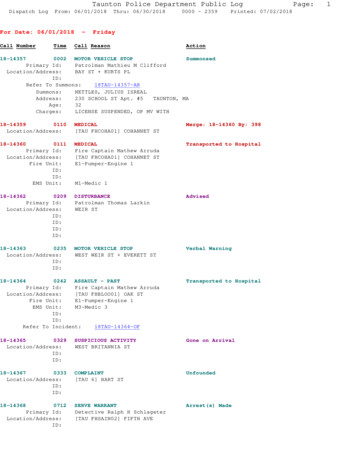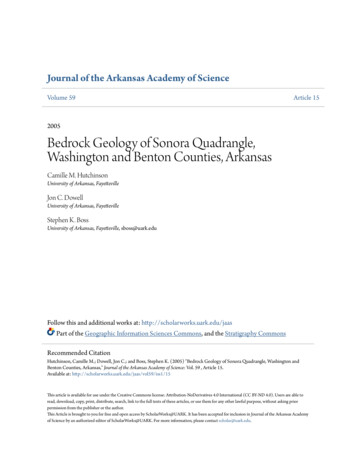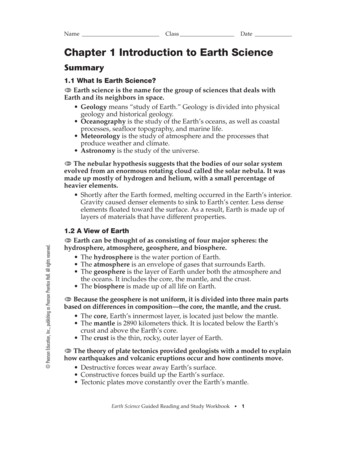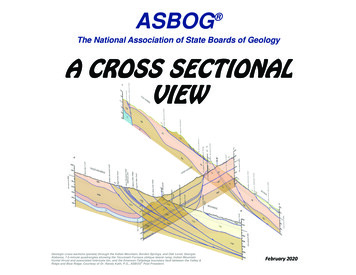
Transcription
Geology of the Taunton"Quadrangle, Bristol andPlymouth CountiesMassachusettsBy JOSEPH H. HARTSHORNGEOLOGY OF SELECTED QUADRANGLES IN red in cooperation with theCommonwealth of Massachusetts' Department of Public ff orks,UNITED STATES GOVERNMENT PRINTING OFFICE, WASHINGTON : 1967
UNITED STATES DEPARTMENT OF THE INTERIORSTEWART L. UDALL, SecretaryGEOLOGICAL SURVEYWilliam T. Pecora, DirectorFor sale by the Superintendent of Documents, U. S. Government Printing OfficeWashington, D.C. 20402
CONTENTS'*'** 1,-i.- 1'i»PageAbstract - - --- ---- --- ---- ------- --Introduction. - ---- --- ---- ------ -------Acknowledgments. . ,. - - - - -- -General setting. .--- - - ' -.Pre-Pleistocene geology and history.Stratigraphy. ---- -------- --- -.Structure. ----- --------- ----- ---- .Geologic history. - - -- ---- ----- ----- -- -Pleistocene geology - - - -- ------ - --- -Glacial erosion.Glacial deposits. - - .- - --------- --- - ------ -------Field and laboratory data.Ground moraine.-.----------- -------------------Flowtill. - -.-.---------.--------.-.-Textural data.Origin of the till ----- ----- ----------------.- -Drumlins. ----- - - - --- - -- - .--Water-laid deposits.Glaciofluvial deposits. - ---- - - - ----- --Ice-channel fillingKame or kame field --- -------------------- ---.Kame terrace. -------------------------------.Kame plain.Outwash plain. - - - -- --- -- :Undivided glaciofluvial depositsGlaciolacustrine deposits.----------------- -------- -.Origin of the water-laid deposits.-------.------.-------Ice-contact slopes.------------------------------Ice-contact deposits --------- Wind actionEolian deposits. - - iVentif acts . 1 1Congeliturbate.Late-glacial history.General chronology - : . - -----.Local chronologyPostglacial history.Economic features.References.48485152565657616364UI
IVCONTENTSILLUSTRATIONSPagePLATE 1. Geologic map of the Taunton quadrangle . In pocketFIGURE 1. Index map of Massachusetts----.-.-------.---.D32-6. Graphs showing cumulative curves for grain sizes in till:2. North-central area.- - -. ---- . ---.133. Pine Street area.154. Southwestern area - -- --------- - ------ -- 165. Southeastern area176. Orchard Street hill.187. Graph showing cumulative curves for grain sizes in flowtills.208. Graph of range in grain size of till ---------- -- - - - -239. Graphs showing number of till samples plotted against mediangrain size and against sorting coefficient.2410-13. Diagrams showing10. Origin of flowtill2911. Cross sections of ice-channel fillings3212. Cross section of kame terrace.3513. Profile of outwash plain .3814. Photograph showing foreset bedding in kame delta.4115. Photograph showing topset bedding in kame delta. . -.4116. Photograph showing varved clay .4217. Diagram showing origin of ice-contact slopes. . . --4518. Graph showing cumulative curves for grain sizes in eolianmaterial5019. Graph showing cumulative curves for grain sizes in congeliturbate -. -----.--- . --5320. Graph showing cumulative curves for grain sizes in materialillustrating transition from till to eolian l measuresLithology of flowtillStatistical measuresStatistical measuresStatistical measuresof till samples - -- --and associated gravelsof eolian materialof congeliturbate.of the transition from till to eolian sandD1227495356
GEOLOGY OF SELECTED QUADRANGLES IN MASSACHUSETTSGEOLOGY OF THE TAUNTON QUADRANGLE, BRISTOLAND PLYMOUTH COUNTIES, MASSACHUSETTSBy JOSEPH H. HARTSHORNABSTRACTThe preglacial history of the Taunton quadrangle of southeastern Massachusetts must be inferred from information on other parts of the Narrangansettbasin of Rhode Island and Massachusetts because the quadrangle is almostentirely covered with glacial deposits. About 25 outcrops of bedrock, consistingof sandstone, shale, and conglomerate of the Rhode Island Formation of Pennsylvanian age, occur in the area. Subsurface data indicate the existence of alarge drift-filled preglacial valley below the Taunton River.Light-gray, yellowish-gray, and pale-yellowish-brown till is exposed over about20 percent of the Taunton map area. Most of the till is of subglacial origin andwas derived predominantly from sandstone of the Rhode Island Formation.Numerous glaciofluvial deposits in the area show evidence of having been laidclown in contact with ice. The general arrangement of the glaciofluvial orglaciolacustrine deposits suggests stagnation of blocks of ice in low areas andthe formation of glaciofluvial deposits around and over the blocks. Flat-lying,lens-shaped bodies of flowtill overlie or are interbedded with sand and graveldeposits of ice-contact origin.Numerous kame plains, kame terraces, ice-channel fillings, kames and kamefields, and large bodies of stratified ice-contact deposits, not easily classifiable,indicate that isolated blocks of ice were present during their formation. Kamedeltas and associated lake deposits, including varved clay, cover part of thequadrangle; some lake-bottom deposits are buried beneath younger outwashplains or swamps.A nearly continuous mantle of eolian sand covers most of the quadrangle todepths ranging from 2 to 5 feet. In places, ventifacts, composed chiefly ofDedham Granodiorite and volcanic rocks, and abraded on all sides, are commonthroughout the eolian sand.Intense frost action late in Pleistocene time is suggested by the wind-abradedventifacts and by congeliturbate a mixture of clean, well-sorted eolian sandand silt and the underlying stratified or unstratified drift.INTRODUCTIONThe Taunton qua'drangle, in southeastern Massachusetts, containsa variety of glacial features whose interrelationship aids in establish Dl
D2ing the probable mode by which the last continental ice sheet melted,and, at least in part, in reconstructing the late-glacial history.The general geology of the Taunton quadrangle was mapped during a total of 135 working days in 1949, 1950, and 1951. The U.S.Geological Survey 7 -minute topographic sheet of the Taunton quadrangle was used as the base map. Aerial photographs were used to alimited extent. The composition and structure of the glacial depositswere observed in natural and artificial exposures. A 14-foot segmentedhand auger was used where necessary in fine-grained materials, but itwas useless in anything coarser than granule gravel.ACKNOWLEDGMENTSThe study of the Taunton area was supervised by Prof. Kirk Bryanfrom its inception in 1949 until the death of Prof. Bryan in 1950.Some of the ideas stated in this paper should properly be credited tohim. Frederick Johnson, of the R. S. Peabody Foundation forArchaeology, Andover, Mass., helped interpret the late-glacial chronology, and the Foundation provided financial help in 1949.Most of the work on which this report is based was done as part ofa cooperative program of the U.S. Geological Survey and the Massachusetts Department of Public Works. Mechanical analyses ofsediments were made in the Department of Public Works soilslaboratory.GENERAL SETTINGThe Taunton quadrange (fig. 1) is an area of about 55 squaremiles in Bristol and Plymouth Counties. It lies in the Seaboard Lowland section of the New England physiographic province (Fenneman,1938) and is a region of relatively low relief. The highest point inthe area is the crest of Prospect Hill, slightly more than 200 feet abovesea level. Most of the topographic features are formed by the largesand and gravel masses that mantle parts of the area. The bedrocktopography markedly affects the present landscape only in the eastern part of the quadrangle, where three elongate hills with reliefof about 70 feet, 100 feet, and 110 feet show a crude northwest-southeast alinement.About 18 percent of the area is covered by swamps, the largest beingHockomock Swamp, in the northern part of the quadrangle. Onelarge body of water, Lake Nippenicket, occupies an elongate southward-trending extension of the swamp.PRE-PLEISTOCENE GEOLOGY AND HISTORYPre-Pleistocene events in the Taunton quadrangle must largelybe inferred from geologic knowledge of other parts of eastern Massa-
GEOLOGY OF THE TAUNTON QUADRANGLED3FIGURE 1. Location of Taunton quadrangle (stippled).chusetts. Thick deposits of drift obscure the irregularities in thepreglacial topography, and bedrock is exposed in only about 25 outcrops, which cover less than 1 percent of the quadrangle. However,general conclusions concerning the pre-Pleistocene geology and topography can be drawn from the few bedrock outcrops and from depthsto bedrock recorded in well data, seismic profiles, and wash borings.STRATIGRAPHYThe Taunton quadrangle lies entirely within the Narragansettbasin, a structural basin and topographic lowland that is partly submerged to the south by the waters of Narragansett Bay. The rocksin this basin are sedimentary and of Pennsylvanian age (Emerson,1917, p. 50; Quinn and Oliver, 1962, p. 68) except for a few prePennsylvanian inliers. Their aggregate thickness is 12,000 feet,Post-Pennsylvanian diabase is found in the Bridgewater quadrangleto the east (Hartshorn, 1960).The Pondville Conglomerate of Pennsylvanian age, the oldest rockexposed in the basin, lies unconformably on older crystalline rocks(Quinn and Oliver, 1962, p. 63). On the northern rim of the basinwhere the Pondville Conglomerate is absent, the base of the section inmost places consists of the red beds of the Wamsutta Formation, whichincludes sandstone, felsite, agglomerate, arkose, and shale (Chute,1950a).
D4GEOLOGY OF SELECTED QUADRANGLES IN MASSACHUSETTSThe Rhode Island Formation (Emerson, 1917, p. 54-55; Quinn andOliver, 1962, p. 64-67) is the most extensive bedrock of the basin. Itoverlies the Pondville Conglomerate and the Wamsutta Formation,and in places rests directly upon the pre-Pennsylvanian crystallinerocks (Quinn and Springer, 1954). The formation generally consists of black shaly and slaty coal-bearing beds interbedded withvariegated shale, sandstone, and conglomerate. The formation contains fossil plants mostly ferns and seed ferns ostracodes, pelecypods, worm trails and tubes, and insects of Middle or Late Pennsylvanian age (Emerson, 1917, p. 55; Quinn and Oliver, 1962, p. 67-68).In the Taunton quadrangle, the Rhode Island Formation is the onlybedrock exposed. It occurs in isolated outcrops of conglomerate,sandstone, shale, and slate; the colors are black, purple, blue green,green, or light gray. Because the outcrops are so widely distributed(pi. 1), and because the lithology varies greatly in short distances,only the larger structures have been recorded. However, the datagiven below may add to the total knowledge of the Narragansett basin.Bedding at three outcrops of blue-gray to gray fine-grained sandstone, shale, and conglomerate in the northwestern part of the quadrangle strikes northeast. The sandstone at Tl1 contains many scattered pebbles up to half an inch in diameter. In a coarse gray sandstone just north of the quadrangle boundary, lenses of conglomeratecontain particles of shale and phyllite and pieces of detrital feldsparup to one-fourth inch in diameter. Chute (1950a) stated that aspecimen taken near Tl was composed of 60 percent angular to subangular grains of quartz, 20-25 percent feldspar (much of which isplagioclase), 15 percent sericite, and minor amounts of carbonate andmuscovite.The southern part of outcrop T2 is generally fissile shale and includes some thin lenses of very fine- to fine-grained sandstone. Thenorthern part of this rocky area is sandstone that contains numerouslenses of conglomerate.In the north-central part of the quadrangle, the New York, NewHaven, and Hartford Railroad goes through a 20-foot-deep cut inbedrock (outcrop T3) for about 1,200 feet. Here the Rhode IslandFormation is a dark-gray medium- to coarse-grained micaceous sandstone containing numerous scattered cobbles and pebbles and somepebble layers. One thick layer of sandy pebble conglomerate rangesfrom 10 to 14 inches in thickness, strikes north, and dips 5 E.; otherpebbly beds are nearly horizontal. Toward the north end of the outcrop, a lens of conglomerate contains ovoid pebbles up to 3 inches in1 Outcrops are labeled T1-T22 on plate 1 for ease of reference.
,.GEOLOGY OF THE TAUNTON QUADRANGLE.D5diameter. In general, the bedding, in this lens, is nearly horizontal,although dips of as much as 28 appear for short distances. Slickensides on. the underside of one ledge plunge 28 S. 10 E.Fine to very coarse grained sandstone containing pebbles up to 1inch in diameter occurs in several abandoned quarries in the westcentral part of the map area (outcrop area T4). These rocks strikeN. 15 W. and dip 6 N. Two-dimensional reddish-brown rustyforms that appear to be carbonized plant remains may be seen on bedding planes. Sheeting nearly parallel to the bedding and to thesurface of the ground is evident in one quarry.There is a bed of gray sandstone containing isolated pebbles andlayers of pebble and cobble conglomerate at outcrop T5. Bedding isobscure because the conglomerate occurs in short thick lenses. Pebblesin the conglomerate are as much as 3 inches in diameter.Outcrops at T6, T7, and T10 are sandstone and conglomerate.Massive gray fine-grained sandstone and shale crop out at T8, andgray-green fissile shale crops out at T9.In an abandoned bedrock quarry at Til, a gray massive coarsegrained sandstone is exposed, and similar rock crops out at T12, about2,100 feet to the south. In neither of these outcrops is the beddingapparent.Interbedded shale and sandstone lenses occur in a conglomerateexposed at T13. Many of the pebbles and cobbles in the conglomerateare composed of quartzite. Some of the shale and sandstone lensesstrike N. 73 E. and dip 55 S., but the attitude of the bedding is notconsistent.In an abandoned quarry east of Johnson Street (T14), gray-bluefissile fine-grained sandstone is exposed. Drusy quartz and epidote arepresent on fracture planes in the rock.Outcrop T15, in the southeastern part of the quadrangle, consists offine-grained slightly metamorphosed sandstone that splits rathereasily into slabs. Mica is concentrated along the fracture planes. Ifthese are bedding planes, the rock strikes N. 75 W. and dips 15 N.,but if differential weathering along other planes indicates bedding, thestrike may be about N. 60 W. and the dip 10 S. -.* .The western outcrop at T16 is composed of small-cobble conglomerate interbedded with shale. The eastern outcrop is composed ofsandstone and beds of cobble conglomerate.An outcrop was noted by Wood worth (in Shaler, and others 1899,p. 200) at T17. The rock is a gray medium-grained sandstone containing 10- to 12-foot beds of pebble and cobble conglomerate; thephenoclasts are up to 6 inches in diameter but average about 2 inches.235-3310 662
D6GEOLOGY OF SELECTED QUADRANGLES IN MASSACHUSETTSMost of the pebbles and cobbles are composed of quartz and quartzite;a few are pink felsite.Outcrops of grayish-purple fine-grained sandstone at T18 and graycoarse-grained sandstone containing pebble bands at T19, togetherwith seismic data, outline the bedrock core (pi. 1) of the hill at LocustStreet in Taunton. A similar bedrock core is indicated by T20, onOrchard Street north of U.S. Route 44; this outcrop is described onpage D9.Gray-blue slate and interbedded fine- to medium-grained sandstonebeds form a ridge about 400 feet long and less than 100 feet wide inthe northeast corner of the quadrangle (T21). Quartz veins as muchas l inches thick occur along several sets of joints. Small beds andlenses of sandstone in the general mass of slate and shale strike aboutN. 65 E. and dip 45 S. Cleavage is prominent in the outcrop; inthe shale near the south end of the bedrock ridge the cleavage strikesN. 80 E. and dips 22 N., and in sandier material near the north end,strikes N. 80 W. and dips 40 N.Woodworth (in Shaler, and others 1899, p. 197) described this outcrop as follows: "* * * pebbly sandstones strike nearly east-westand dip about 20 north, forming a low monoclinal ridge with anescarpment facing south." Apparently Woodworth misinterpretedcleavage as bedding.In a hill near Scotland at T22, gray shale crops out in a ditch,indicating that the hill has a bedrock core.Just south of the quadrangle, conglomerate was exposed 5 feet belowthe surface of County Street, in a bridge, excavation. The conglomerate is composed of pebbles and cobbles of granite, shale, quartzite, sandstone, and fine-grained volcanic (?) rock in a matrix of medium- tovery fine-grained sandstone. The pebbles and cobbles are spheroidalto ovoid in shape and usually break free from the matrix when therock is crushed or broken. The rock, however, may break through thepebbles instead of around them; the large stones appear to break freemore easily than the smaller stones. The rock fits the description ofthe Dighton Conglomerate (Woodworth, p. 184, in Shaler, and others1899). Therefore, the syncline in which the Dighton Conglomeratewas named may extend almost to the southern border of this quadrangle. This cannot be proved until more detailed bedrock mappingis done in the Assonet and Somerset quadrangles.STRUCTUREAn anticline may be present in the northern half of the Tauntonquadrangle. The probable axis extends east-northeast from west ofthe quadrangle near Watson Pond, through the bedrock outcrops at
GEOLOGY OF THE TAUNTON QUADRANGLED7T3, and eastward. The axis of a northeastward-striking syncline mayenter the quadrangle near the southwest corner and continue east nearthe Taunton Court House and north of Forest Street (Kaynham)near the east edge of the quadrangle. This may be the Taunton syncline (Quinn and Oliver, 1962, p. 70), which strikes toward Tauntonfrom the Norton quadrangle to the west where its presence is indicatedby large outcrops of Dighton Conglomerate. More mapping to thesouth and west may help to clarify the structure of the Taunton area,but details will probably remain obscure because exposures are so few.GEOLOGIC HISTORYThe Pennsylvanian rocks probably were deposited in the broadcrustal downwarp of the Narragansett basin. This basin must havebeen separated from the sea during all of Pennsylvanian time, becausethe rocks of Pennsylvanian age in the basin contain nonmarine fossils(Shaler, and others, 1899, p. 202). A general uplift near the end ofthe Pennsylvanian Period is indicated by the presence of coarse conglomerates that are now the youngest rocks exposed in the area. Thefolding of the original basin may have been related to a late phase ofthe Appalachian Revolution, perhaps in Permian (?) time (Quinn andOliver, 1962, p. 70).Unconsolidated sands containing glauconite are exposed in theMarshfield Hills area of the Duxbury and Scituate quadrangles, about22 miles northeast of Taunton (N. E. Chute, oral commun., 1955).These beds are probably either Tertiary or Cretaceous in age(Bowman, 1906, p. 313) and may have extended inland across theTaunton quadrangle. However, uplifts in the Tertiary Period andsubsequent erosion resulted in deep dissection of central and easternMassachusetts and the removal of the sediments from the Tauntonarea.Valleys that were formed in the Narragansett Bay area and thenwere filled with glacial deposits are now well below sea level, indicating that the preglacial land surface was much higher, relative to sealevel, than the present land surface. The Taunton River flows abovea preglacial valley (pi. 1), whose floor, now covered with glacial drift,is generally about 30-60 feet below sea level. The gradient in theancient valley has not been determined. In the Bridgewater quadrangle to the eastr the Taunton River flows on bedrock at about 10 feetabove sea level (Hartshorn, 1960). Northeast of this shallow-bedrockarea the Taunton River flows over a preglacial depression that is atleast 65 feet below sea level. Hence, the preglacial valleys in the areado not exactly determine the present course of the Taunton River.
D8GEOLOGY OF SELECTED QUADRANGLES IN MASSACHUSETTSPLEISTOCENE GEOLOGY -Unconsolidated deposits of Pleistocene age mantle almost all theTaunton quadrangle. The southeast-moving ice sheet eroded andbroke up the bedrock, transported it a short distance, and deposited itas till. Stratified deposits, here classified by landform, are presentin great variety. The pattern of ice-contact deposits, proglacial deposits, and glaciolacustrine deposits has been used to reconstruct a lateglacial chronology for the area.GLACIAL EROSIONEvidence of glacial erosion of bedrock in the Taunton quadrangleis provided by the enormous masses of glacial drift. The unweatheredcondition of nearly all the stones and the matrix of the stratified andunstratified drift deposits suggests that the material must have beenderived from un weathered bedrock. The glacial drift may representseveral ice advances, each of which contributed to the bulk of the unweathered material.The tremendous erosive power of the ice sheet is shown by a glacialboulder just north of the bedrock quarry near Whittenton Junction.The boulder, called Castle Eock by the local inhabitants, measuresapproximately 29 by 33 by 19 feet. It is composed of sandstone and ofpebble arid cobble conglomerate whose phenoclasts average about 3inches in diameter. Outcrops of similar rocks are located about 4%and 9 miles to the northwest; the more distant are in the Norton andMansfield quadrangles (Woodworth, in Shaler and others, 1899,p. 196). Therefore, the ice sheet must have moved the boulder at least4 2 miles.Very deep glacial erosion has been postulated for some places inNew England. At Iron Hill, R.I., Shaler (1893, p. 208) estimatedthat 300 feet of rock had been removed from the hill. In Massachusetts, the relatively soft rocks of the Narragansett basin must haveyielded to the glaciers. As'it is only a short distance from thenorth edge of the basin to the Taunton quadrangle, a large amount ofmaterial from the Rhode Island Formation must have been draggedup into the ice, released, sorted, and deposited by glacial streams asglaciofluvial and glaciolacustrine landf orms.Jahns (1943) used the relation between sheet structure in granitesand existing topography to demonstrate that, in general, 10-15 feetof rock and preglacial regolith were removed by glacial plucking andabrasion from the stoss (north) slopes of most hills in northeasternMassachusetts; A somewhat greater amount was eroded from thesummits and east and west slopes of the hills. The deepest erosiontook place where well-jointed granites and a steep preglacial slope
GEOLOGY OF THE TAUNTON QUADRANGLED9on the lee side of the hill favored plucking. The maximum demonstrable localized erosion is in excess of 100 feet (Jahns, 1943, p. 94).Glacial erosion was not so effective everywhere in New England.In numerous localities for example, in southern Rhode Island (J. P.Schafer, oral commun., 1960) the ice sheet did not erode preglacialweathered rock. Just west of the intersection of U.S. Route 44 andOrchard Street in Taunton, an excavation for a highway disclosedthe presence of deeply weathered rock that has been preserved beneathunweathered till. A section shows:InchesTill, grayish-yellow (oxidized) to light-gray (unoxidized)Sandstone, medium- to fine-grained, gray, soft, weathered; shaly layersSandstone, medium- to coarse-grained, yellowish-gray, soft, weathered;complexly intermingled with clay streaks ;Sandstone, fine-grained, gray, somewhat soft, weatheredConglomerate; material granule to very small pebble size; mostly gray;some iron staining; soft; weatheredClay, gray to brown; grades upward into fine-grained sandstoneSandstone, medium to very coarse grained, gray; contains unorientedirregular streamers of clayClay, laminated, blue-gray; interbedded with lenses and stringers offine sand36262818132146A good exposure nearby shows an upward gradation from shaleinto blue clay similar to that found in the section. The presenceof unweathered till at the top of the cut shows that the materialbelow was weathered before the most recent glaciation. Hence, softmaterials are not necessarily deeply eroded, even though elsewherein the quadrangle the depth of erosion and the size of joint blocksplucked away by the glacier may be considerable.Direct evidence of glacial abrasion was found about a mile southof Lake Sabbatia, where quarry operators had stripped the coverof till and glaciofluvial sand from the bedrock. Striations in thebedrock surface occur at several places around the quarry and areoriented S. 30 E. The one mapped drumlin in the area and severaltill-mantled bedrock-cored hills are similarly oriented.GLACIAL DEPOSITSTILL-According to Flint (1957, p. 109), glacial deposits form a texturalseries that ranges from stratified and well-sorted glacial drift (glaciofluvial deposits) to unstratified and poorly sorted or nonsorted debris (till). Between these two end members, there is an indeterminatezone in which sediments grade from recognizable stratified drift tosediments that may be either glaciofluvial deposits or till. Furthermore, sand and gravel lenses occur in, and were formed as an integral
D10GEOLOGY OF SELECTED QUADRANGLES IN MASSACHUSETTSpart of, otherwise unstratified and unsorted till. The scale of themap prevents a precise delineation of all patches of stratified and unstratified drift; therefore, mapping some areas of poorly sorted andstratified glaciofluvial deposits as very sandy till and omitting smallkames and terraces may slightly distort the glacial history.Previously published maps of surficial geology in New Englandhave shown the general covering of till as ground moraine (Chute,1950b; Jahns, 1953) or as till (Goldsmith, 1962). Flint (1957, p.131) noted that thin till lacking topographic expression other thanthat of the immediately underlying bedrock surface is not properlycalled ground moraine it is a stratigraphic unit rather than a topographic unit. Till in the Taunton quadrangle has modified the preglacial topography so that the present landforms are more smoothlycontoured than the underlying irregular bedrock topography. Hence,the general till cover is mapped as ground moraine.Ground moraine also implies accumulation beneath a glacier. Possibly, however, at least some part of the till in the Taunton quadrangleaccumulated as superglacial debris let down onto the substratum. Nosure criteria have been found to distinguish between lodgement till,which is till that has accumulated at the bottom surface of the glacier,and ablation till, which is till that has made its way down onto thesubstratum as the ice melts away. In the absence of definite proof ofsuperglacial origin, it is assumed that the greater part of the till coveris of subglacial origin and is indeed ground moraine.The distribution of areas blanketed by till is shown on plate 1. Inmany places the distribution is directly related to bedrock hills, as onthe southeast-trending ridges in the southeast quarter of the quadrangle and in the area south of Scotland, in the northeastern part ofthe quadrangle.The color of the till in the Taunton quadrangle varies from duskyyellow to light brown under field conditions that is, under varyingconditions of moisture, However, samples dried and compared underthe same light source differ very little. The colors are generally lightgray, gray, yellowish gray, and pale yellowish brown (Goddard andothers, 1948). Mottling is common in some of the tills and producesa moderate-yellowish-'brown color in a lighter colored matrix.Macroscopic estimates and grain-size analyses show that, in general, the matrices of these tills are dominantly sandy to silty. Therock fragments in the till generally are angular to subangular, andmany of them have been modified by glacial abrasion. Numerousfragments are striated on one or more surfaces.Glacial erratics of granite, granodiorite, and several types of volcanic rocks are found in the quadrangle. These are more numerous
GEOLOGY OF THE TAUNTON QUADRANGLEDllin the north, close to the north edge of the Narragansett basin. Mostof the large boulders that rest on or project through the till are composed of sandstone and conglomerate from the underlying RhodeIsland Formation. The surfaces of some of these large boulders anderratics have been polished and carved by windblown sand.FIELD AND LABORATORY DATAIn addition to color, induration, pebble lithology, and other physicalproperties, grain-size analyses have been used as a basis for distinguishing between various types of tills in Massachusetts (Crosby,1891; Segerstrom, 1955; Moss, oral commun., 1948). Similar analyseshave been made for till in New Hampshire (Goldthwait, 1948). Mostof these grain-size analyses used only four grades,2 and cumulativecurves based on so few points do not give a satisfactory base for statistical comparison with other samples.Mechanical analyses were made of 23 samples from the Tauntonquadrangle and of 1 from the adjacent Bridgewater quadrangle. Theresults of these analyses were then compared with the results of manyanalyses made by other geologists.Only the matrix of the till was analyzed. Samples contained rocksup to pebble size but were chosen to define the textural character of thatpart of the till matrix smaller than 64 mm. The Wentworth size classification (Wentworth, 1922) is used in this report for general description of the sediment grain sizes.In the laboratory, the samples were dr
The Taunton quadrange (fig. 1) is an area of about 55 square miles in Bristol and Plymouth Counties. It lies in the Seaboard Low land section of the New England physiographic province (Fenneman, 1938) and is a region of relatively low relief. The highest point in the area is the crest of Prospect Hill, slightly more than 200 feet above .










